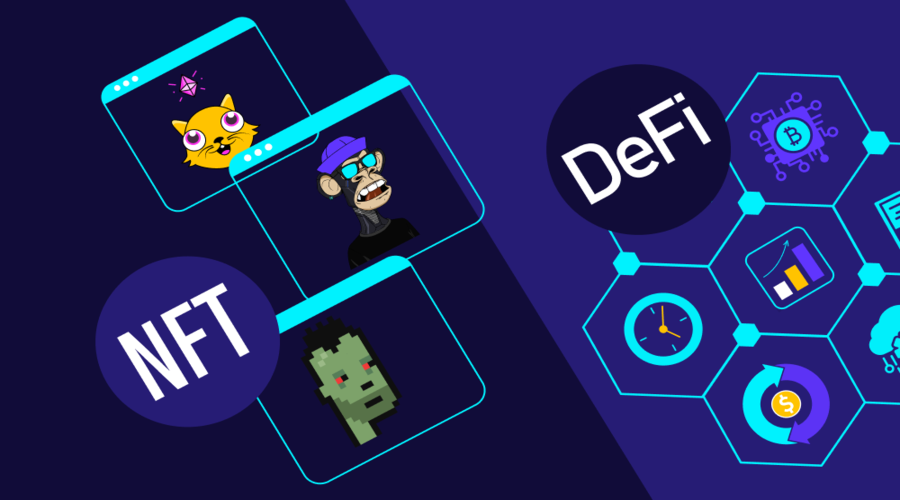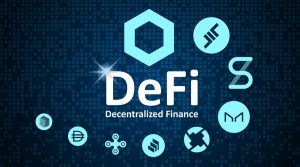With the emergence of blockchain technology, the world of finance is changing rapidly. Non-fungible tokens (NFTs) and decentralized finance (DeFi) are two of the most exciting areas in this space. NFTs are unique digital assets that are stored on a blockchain, while DeFi refers to financial services that are built on top of decentralized networks. In this article, we will explore the intersection of NFTs and DeFi and the potential impact they could have on the future of finance.
Introduction
The advent of blockchain technology has enabled the creation of unique digital assets that cannot be replicated or duplicated. These assets are called non-fungible tokens (NFTs). NFTs are stored on a blockchain and can represent anything from digital art to virtual real estate. On the other hand, DeFi refers to financial services that are built on top of decentralized networks. These services are designed to be transparent, secure, and accessible to everyone, regardless of their location or financial status.
What are NFTs?
NFTs are unique digital assets that are stored on a blockchain. They can represent anything from digital art to virtual real estate. NFTs are different from fungible tokens like Bitcoin or Ethereum because they are not interchangeable. Each NFT is unique and has its own value. NFTs are created using smart contracts, which are self-executing computer programs that run on a blockchain.
What is DeFi?

Decentralized finance (DeFi) refers to financial services that are built on top of decentralized networks. These networks are powered by blockchain technology and are designed to be transparent, secure, and accessible to everyone. DeFi services include things like borrowing and lending, trading, and insurance. DeFi services are often faster and cheaper than traditional financial services because they are not subject to the same regulatory constraints.
NFTs in DeFi: Use Cases and Benefits
NFTs have several use cases in the DeFi space. Some of the benefits of using NFTs in DeFi include:
Liquidity Provision
NFTs can be used to provide liquidity to DeFi protocols. Liquidity providers can deposit NFTs into a smart contract and earn rewards in return. These rewards can be in the form of tokens or other NFTs.
Fractionalization of Assets
NFTs can also be used to fractionalize assets. This means that a single asset can be divided into multiple NFTs, each representing a share of the asset. Fractionalization allows for more people to invest in an asset and can increase liquidity.
Collateralization
NFTs can also be used as collateral in DeFi protocols. This means that NFT holders can borrow tokens by using their NFTs as collateral. This is similar to how traditional lenders use physical assets like real estate or cars as collateral.
Challenges and Risks
While NFTs and DeFi have the potential to revolutionize the world of finance, there are also several challenges and risks associated with these technologies. Some of the main challenges and risks include:
Regulatory Issues
The regulatory landscape around NFTs and DeFi is still uncertain. Many governments around the world are still figuring out how to regulate these technologies. This uncertainty can lead to legal challenges and could slow down the adoption of these technologies.
Smart Contract Risks
NFTs and DeFi services are built using smart contracts, which are self-executing computer programs that run on a blockchain. Smart contracts are designed to be transparent and secure, but they are not foolproof. Bugs in smart contracts can lead to security vulnerabilities, which could be exploited by malicious actors.
The Potential of NFTs in the Art World
NFTs have already made a big splash in the art world, with some pieces selling for millions of dollars. The use of NFTs allows artists to sell their digital art as unique and valuable pieces, rather than just as copies. This has the potential to completely disrupt the art world and how we value and purchase art.
The Risks of Investing in NFTs
While NFTs have the potential for big profits, they also come with significant risks. The value of NFTs can be highly volatile, and there is a risk of fraud and scams in the market. It’s important for investors to understand these risks and do their research before investing in NFTs.
The Role of DeFi in Banking the Unbanked
DeFi has the potential to provide financial services to the millions of people around the world who are currently unbanked or underbanked. Because DeFi services are built on decentralized networks, they can be accessed from anywhere in the world, without the need for a traditional bank account. This has the potential to provide financial inclusion to those who have been left out of traditional banking systems.
The Future of DeFi and Traditional Finance
As DeFi continues to grow and evolve, it’s worth considering how it will impact traditional finance. Will DeFi completely replace traditional banks and financial institutions, or will the two coexist in some way? This is an important question that will shape the future of finance.
The Ethical Implications of NFTs and DeFi
As with any new technology, there are ethical implications to consider. For example, the high energy usage of blockchain technology and the potential for the exclusion of certain groups from DeFi services. It’s important to consider these ethical implications and work to mitigate any negative impacts.
NFTs and Gaming
NFTs are also making a big impact in the gaming industry. Game developers can use NFTs to create unique and rare in-game items that players can buy, sell, and trade. This creates a new level of value for in-game items and allows players to truly own their virtual assets.
The Environmental Impact of NFTs and DeFi
Blockchain technology, which underlies both NFTs and DeFi, requires a significant amount of energy to operate. This has led to concerns about the environmental impact of these technologies. It’s important for the blockchain community to find ways to reduce energy usage and mitigate the environmental impact of these technologies.
The Role of Governance in DeFi
Decentralized networks rely on governance to make decisions about how the network should operate. In the case of DeFi, governance can determine things like interest rates and collateral requirements. Understanding how governance works in DeFi is key to understanding how these services operate.
NFTs and Collectibles
NFTs have also made a big impact in the world of collectibles. Collectors can use NFTs to own unique and rare digital items, such as virtual trading cards or collectible items in video games. This has opened up a new market for collectors and created new opportunities for creators.
The Potential for DeFi in Developing Countries
DeFi has the potential to provide financial services to people in developing countries who may not have access to traditional banking systems. By using decentralized networks, people can access financial services without needing a bank account or other traditional forms of identification. This has the potential to increase financial inclusion and reduce poverty.
These are just a few more subtopics to consider when exploring NFTs and DeFi. By understanding these topics, we can gain a deeper understanding of the potential and risks associated with these technologies and their impact on the world.
The Role of NFTs in Music
NFTs have the potential to revolutionize the music industry by allowing artists to sell unique digital assets such as album art, concert tickets, and music rights. This allows artists to monetize their work in new ways and gives fans the opportunity to own exclusive, rare items.
The Security Risks of DeFi
DeFi services are built on decentralized networks, making them less vulnerable to traditional cyberattacks. However, there are still security risks associated with DeFi, such as smart contract vulnerabilities and hacking attempts. It’s important for users to take precautions and understand the risks involved in using these services.
The Legal Implications of NFTs and DeFi
As NFTs and DeFi continue to grow in popularity, there are legal questions that need to be addressed, such as how to regulate these technologies and how to handle disputes. It’s important for the legal system to adapt to these new technologies and provide clarity on how they fit into existing legal frameworks.
NFTs and Real Estate
NFTs have the potential to revolutionize the real estate industry by allowing for the fractionalization of property ownership. This would make it easier for more people to invest in real estate and increase liquidity in the market. Additionally, NFTs could be used to represent unique features of a property, such as mineral rights or air rights.
The Potential for DeFi in Traditional Finance
DeFi has the potential to disrupt traditional finance by offering faster, cheaper, and more accessible financial services. However, it’s also possible that traditional finance could adopt some aspects of DeFi to improve their own services. It’s important to consider how these two worlds may intersect in the future.
These are just a few more subtopics to consider when exploring NFTs and DeFi. By understanding these topics, we can gain a deeper understanding of the potential and risks associated with these technologies and their impact on various industries.
Conclusion
NFTs and DeFi represent the future of finance. The intersection of these two technologies has the potential to revolutionize the world of finance by providing transparency, security, and accessibility to everyone. NFTs can be used to provide liquidity, fractionalize assets, and collateralize loans in DeFi, while DeFi services can provide financial services to anyone, anywhere in the world. However, there are also risks and challenges associated with these technologies, such as regulatory issues and smart contract risks. Overall, NFTs and DeFi are still in their early stages, but the potential they hold for the future of finance is enormous.











